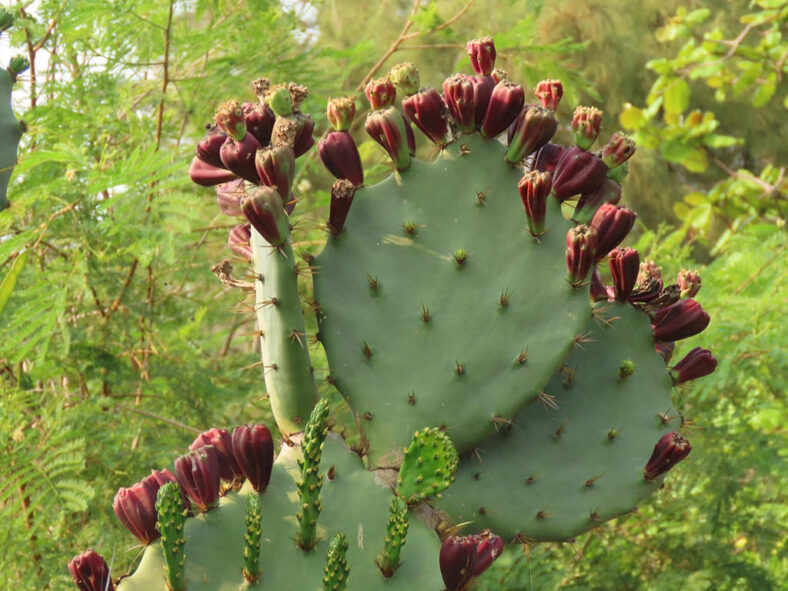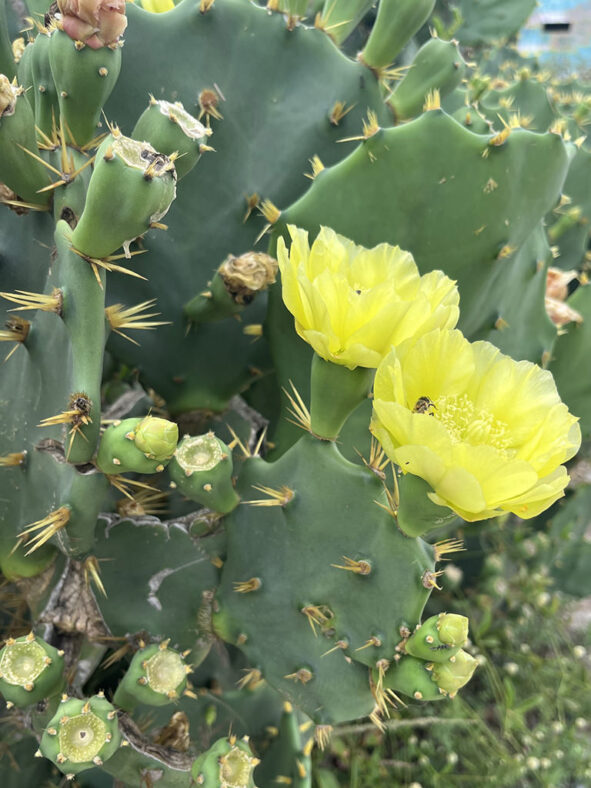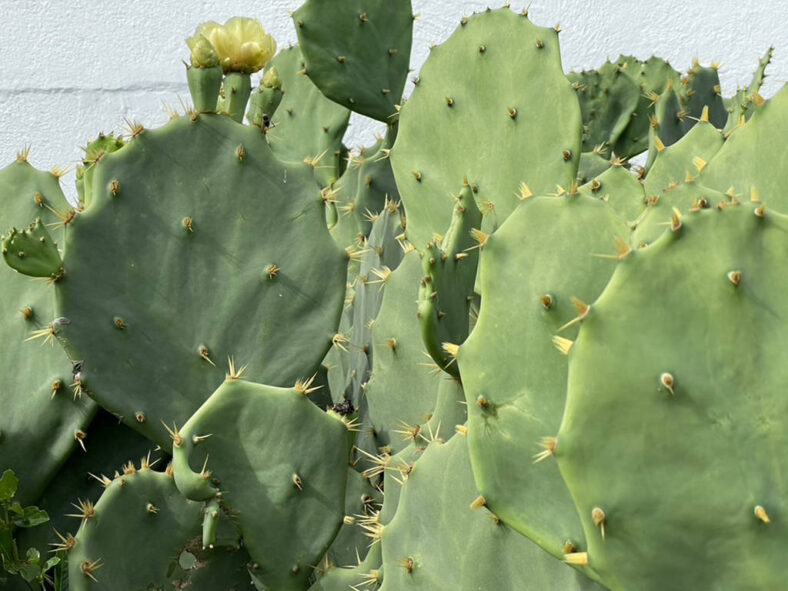Some botanists treat Opuntia dillenii as a variety of Opuntia stricta, while others do not recognize it at all. Although both plants can grow in similar habitats, they have distinct differences. One key distinction is that Opuntia dillenii typically has joints with undulated edges. Additionally, Opuntia dillenii is often much spinnier than Opuntia stricta.
Scientific Name
Opuntia dillenii (Ker Gawl.) Haw.
Comon Name(s)
Dillen's Prickly Pear, Erect Pricklypear, Flat Hand Dildo, Jumbie Prickle, Seaside Tuna, Sour Prickle
Synonym(s)
Cactus dillenii, Opuntia stricta var. dillenii, Opuntia zebrina
Scientific Classification
Family: Cactaceae
Subfamily: Opuntioideae
Tribe: Opuntieae
Genus: Opuntia
Etymology
The specific epithet "dillenii" (pronounced "dil-LEN-ee-eye") honors Johann Jacob Dillenius (1684-1747), a German botanist who was a professor of botany at the University of Oxford.
Origin
Opuntia dillenii is native to the southeastern United States, eastern Mexico, and the West Indies, but it was introduced to northern South America. It is one of the most common Opuntia species in dry coastal scrub vegetation.
Description
Opuntia dillenii, also known as Opuntia stricta var. dillenii, is an erect or spreading shrub with numerous lateral branches composed of inversely ovate to subcircular joints. This cactus can grow up to 10 feet (3 m) tall and has either no trunk or a short, nearly cylindrical one. The joints are green to gray-green, have brown glochids, and typically 3 to 7 yellow to yellowish brown spines per areole. They can reach a length of 16 inches (40 cm) long and a width of 10 inches (25 cm) wide. The spines, which can measure up to 2.4 inches (6 cm) long, are awl-shaped, slightly flattened, and straight or somewhat curved. The deciduous leaves are slender, tapering to a point, and can grow up to 0.25 inches (0.6 cm) long.
From summer to mid-fall, Opuntia dillenii produces yellow flowers with a diameter that can reach 3.6 inches (9 cm). The fruits are reddish to purple, pear-shaped, with persistent glochids. They contain yellowish-brown seeds and can grow up to 2.4 inches (6 cm) long and 1.6 inches (4 cm) in diameter.

How to Grow and Care for Opuntia dillenii
Light: Opuntia dillenii thrives in full sun, but some shade during midday and afternoon can prevent sunburn in hot climates. When grown indoors, it works best in a window that receives sunlight for 6 hours a day.
Soil: This cactus requires a well-draining soil mix. You can use a commercial cactus potting mix or create your own.
Temperature: Opuntia dillenii is highly tolerant of high temperatures and prefers cooler temperatures in winter. It grows best in USDA Plant Hardiness Zones 9b to 11b, with average minimum winter temperatures ranging from 25 to 50 °F (-3.9 to 10 °C).
Watering: From spring to fall, water moderately and let the soil dry out completely before watering again. In most areas, rainfall will be enough for established plants. If potted, never let the container sit in water. Suspend watering during the winter.
Fertilizing: Opuntia dillenii does not need fertilizer when planted in the ground. However, it will benefit from fertilizing during the growing season when grown in a container. Apply a water-soluble fertilizer. Suspend feeding during the winter when the plant goes dormant.
Repotting: Repot only when the cactus becomes potbound or is too large and unstable in its container. Choose a slightly larger container with drainage holes at the bottom. The best time for repotting is late winter or early spring.
Propagation: Opuntia dillenii can be propagated by stem segments or seeds. The easiest method is by stem segments, which yields faster results. For best results, take the stem segments in early summer and sow the seeds in late spring.
Learn more at How to Grow and Care for Opuntia.
Toxicity of Opuntia dillenii
Opuntia dillenii is not toxic to humans or pets. However, it is best to keep this plant away from pets and children, as its harmful spines and glochids may cause skin irritation.
Forms of Opuntia dillenii
Links
- Back to genus Opuntia
- Succupedia: Browse succulents by Scientific Name, Common Name, Genus, Family, USDA Hardiness Zone, Origin, or cacti by Genus
Photo Gallery
Click on a photo to see a larger version.


